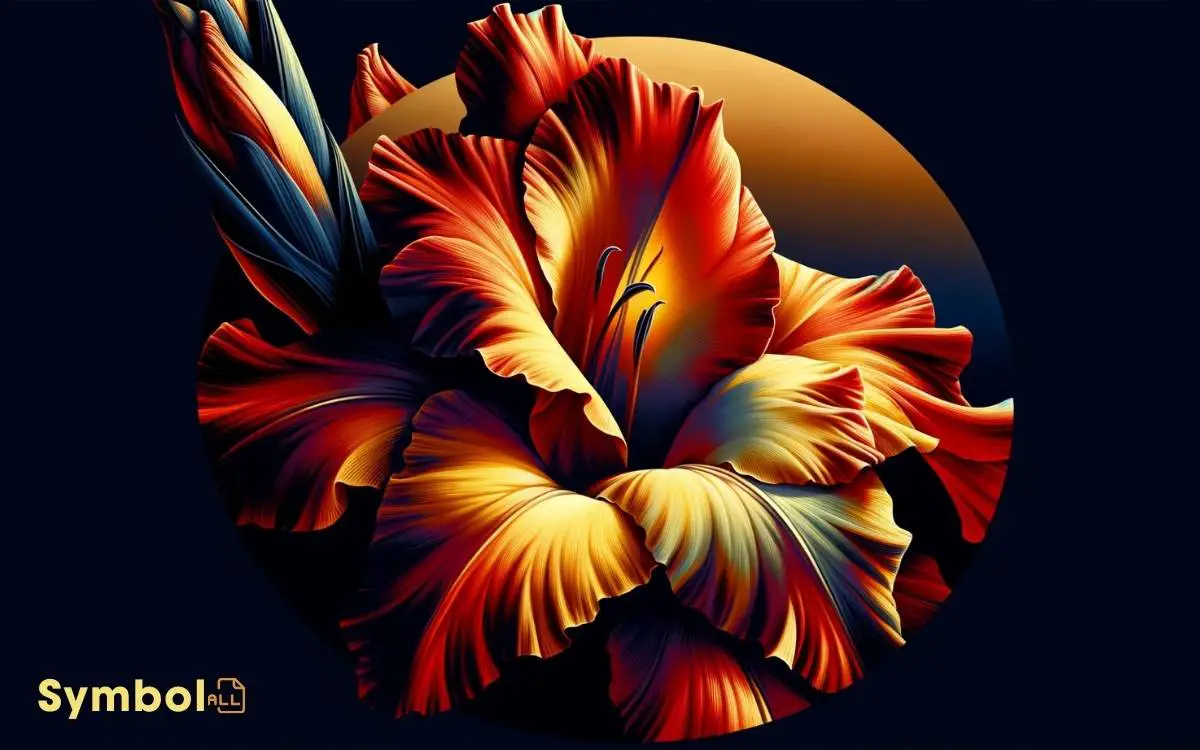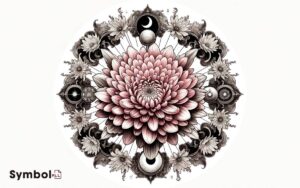What Flower Symbolizes Strength and Courage? Gladiolus!
The Gladiolus symbolizes strength and courage, drawing its name from the Latin word for sword. Its tall, sword-like stems and vibrant blooms, with a linear growth pattern and pointed tips, emulate moral integrity.
This flower’s unique inflorescence guarantees efficient pollination. Historically revered from ancient times, it was associated with gladiators in Roman times, serving as an emblem of moral integrity and strength.
Across cultures, flowers like the Gladiolus carry nuanced meanings, with colors rooted in their phytochemical compositions.
Understanding the botanical and cultural significance of the Gladiolus could enhance your appreciation of its role in expressing inner resilience and bravery.

Key Takeaways
The Gladiolus: A Symbol
The Gladiolus, deriving its name from the Latin word for sword, symbolizes strength and moral integrity due to its tall, sword-like stems and vibrant blooms. You’ll find it fascinating that this plant, through its physical attributes, conveys such powerful meanings.
Its linear growth pattern and pointed tips mirror the qualities of resilience and sharpness, both literally and metaphorically.
In the domain of botany, the Gladiolus stands out for its unique inflorescence, which is a term describing the manner in which its flowers are arranged on the stem.
This arrangement isn’t just aesthetically pleasing; it’s a marvel of nature’s design, promoting efficient pollination and maximizing exposure to sunlight.
Such characteristics underscore the Gladiolus’s symbolic representation of overcoming challenges through persistence and inner strength.
Historical Significance
Delving into the past, you’ll uncover that Gladioli have been revered since ancient times for their symbolic association with strength and moral integrity, deeply entwined with various cultural narratives and historical events.
| Era | Significance |
|---|---|
| Roman Times | Associated with Gladiators, symbolizing victory in combat. |
| Renaissance | Emblem of moral integrity and strength of character. |
| 18th Century | Became a token of admiration and respect. |
| Victorian Era | Integrated into bouquets to convey strength of character. |
| Modern Times | Continues to represent strength, moral integrity, and persistence. |
This table illustrates the evolutionary significance of Gladioli, highlighting its persistent symbolization of strength through various epochs.
Analyzing its historical context provides a deeper understanding of why Gladioli are universally acknowledged as emblems of courage and fortitude.
Cultural Representations
You’ll find that flowers carry nuanced meanings across different cultures, often symbolizing strength and courage in unique ways. Analyzing global symbolic meanings requires understanding the historical contexts that shaped these perceptions.
This comparative approach highlights the diversity of interpretations and the universal appeal of certain flowers in embodying resilience.
Global Symbolic Meanings
Across cultures, specific flowers embody the essence of strength and courage, serving as symbols with deep-rooted historical significance.
For instance, the lotus in Eastern traditions represents purity and resilience, thriving in muddy waters yet emerging unscathed. This capacity for regeneration symbolizes an individual’s ability to overcome adversity.
In contrast, the Western world often associates the oak with strength, but when delving into the floral domain, the rose stands out. Despite its delicate appearance, the rose, with its thorny stem, signifies the courage to persist and the beauty in overcoming challenges.
Analyzing these symbols, you’ll find a common thread: resilience against the odds.
This global perspective enriches your understanding of how flowers can encapsulate complex human emotions and virtues, transcending linguistic and cultural barriers to offer universal messages of strength and courage.
Historical Significance
Throughout history, various cultures have attributed significant meanings to flowers, using them as emblematic representations of strength and courage in their societal narratives and rituals.
For instance, ancient Greeks associated the gladiolus with moral integrity and bravery, often bestowing it upon warriors to signify their valor in battle.
Similarly, in Chinese culture, the peony is revered as a symbol of bravery and honor, often depicted in art and literature alongside lions, known for their majestic strength.
Analyzing these cultural representations, you’ll find a complex web of symbolism that transcends mere aesthetic appreciation.
These flowers serve as conduits for conveying societal values, embodying the collective admiration for resilience and fortitude across different epochs and civilizations.
Varieties and Colors
You’ll find that the varieties of flowers symbolizing strength and courage are diverse, each with unique botanical characteristics.
The significance of colors in these plants isn’t arbitrary; it’s rooted in specific phytochemical compositions and historical associations.
Analyzing popular strength varieties alongside courageous colors reveals a complex interplay between cultural perceptions and the natural world.
Popular Strength Varieties
Among the various flowers symbolizing strength and courage, certain varieties and colors stand out for their specific associations and meanings.
Gladiolus, deriving its name from the Latin word for sword, exemplifies strength and moral integrity. Its vertical growth and pointed leaves metaphorically represent resilience.
Sunflowers, with their sturdy stalks and ability to turn towards the sun, symbolize adoration and loyalty, reflecting an inherent strength in positivity and devotion.
Peonies, with their lush, full blooms, convey a message of bravery and honor, reminiscent of their use in ancient cultures for protective purposes.
Each of these varieties holds a unique position in the botanical domain, chosen for their emblematic properties which resonate with human experiences of strength and courage.
Courageous Colors Significance
Expanding upon the varieties that embody strength and courage, it’s also important to contemplate how specific colors within these species further encapsulate these qualities.
Red, often associated with vitality and bravery, imbues flowers like the rose and poppy with an aura of fearless love and remembrance.
Yellow, symbolizing joy and friendship, highlights resilience in sunflowers, which turn their faces towards the sun, embodying optimism and perseverance.
Purple, a color denoting dignity and pride, graces irises and lilacs, showcasing an elegance that stands tall in the face of adversity.
Analyzing the chromatic spectrum within these botanical wonders reveals a nuanced understanding of how pigmentation contributes to their symbolic representation of strength and courage, inviting a deeper appreciation of their roles in human culture and emotion.
Growing and Care Tips
To ensure optimal growth and vitality, it is essential to provide your flower with the correct balance of sunlight, water, and nutrient-rich soil. Understanding the specific requirements of your flower species enhances its resilience and bloom intensity.
| Factor | Recommendation |
|---|---|
| Sunlight | 6-8 hours daily |
| Water | 1-2 inches weekly |
| Soil Type | Well-draining |
| Fertilization | Monthly during growing season |
Each factor plays a pivotal role in the plant’s development. Sunlight is necessary for photosynthesis, the process by which plants convert light into energy. Adequate watering, without over-saturating, supports vital cellular functions and nutrient transport.
Soil quality influences root health and nutrient uptake. Regular fertilization provides essential nutrients that might be depleted from the soil, promoting robust growth and flowering.
Symbolism in Art and Literature
In art and literature, the flower symbolizing strength and courage frequently serves as a powerful emblem, deeply embedded with cultural and emotional significance, reflecting human experiences and societal values.
This motif, often laden with complex symbolism, articulates themes of resilience, perseverance, and the triumph of spirit over adversity.
Through a detailed, analytical lens, one observes how specific flowers are chosen within various contexts to convey nuanced messages.
The choice of a particular flower, its color, state (bloomed or wilted), and even its placement within a composition, are meticulously considered to enhance the narrative or thematic depth.
Such symbols enrich the tapestry of human expression, offering insights into the collective psyche, and underscoring the enduring link between nature and the human condition.
Gifting and Personal Reflection
Gifting a flower that symbolizes strength and courage not only conveys deep personal sentiments but also invites the recipient to engage in a moment of introspection and personal reflection.
This act triggers a cognitive process, stimulating an emotional and psychological response grounded in the symbolic meaning of the flower. It encourages the receiver to contemplate their own resilience and bravery in the face of challenges.
Scientifically, the act of receiving a meaningful gift can enhance one’s emotional well-being, fostering a sense of support and understanding.
Analytically, when you choose a flower with such powerful symbolism, you’re leveraging centuries of cultural and botanical significance, offering more than a mere gesture; you’re providing a tool for personal growth and self-awareness.
Conclusion
In sum, the Gladiolus stands as a beacon of strength and courage, its roots deeply entwined with historical and cultural significance.
Through its diverse palette and varieties, it not only thrives in the garden of botany but also flourishes in the domains of art and literature.
As you nurture these spears of resilience, remember they’re not just plants but symbols, encapsulating tales of valor. Like a warrior’s blade, they cut through life’s adversities, reminding us of our inner fortitude.






